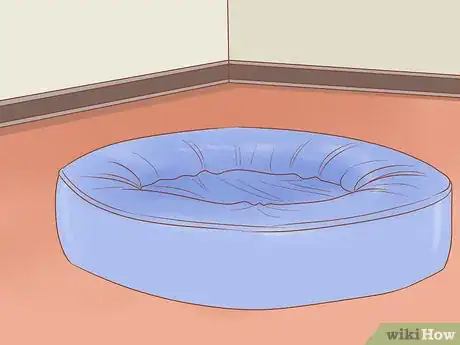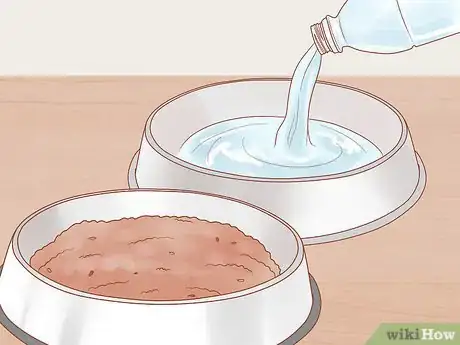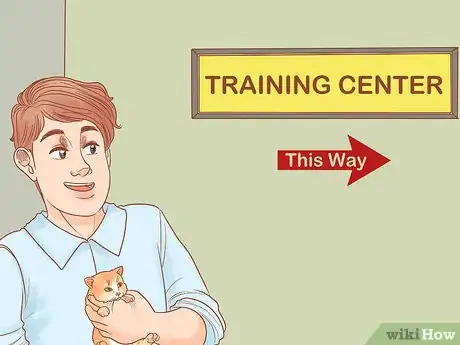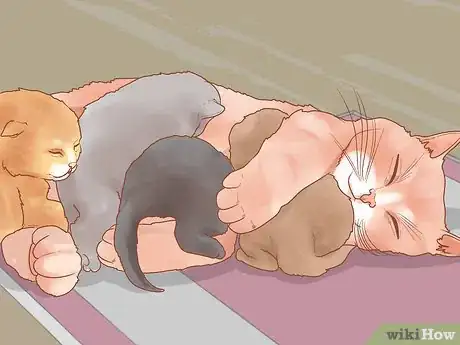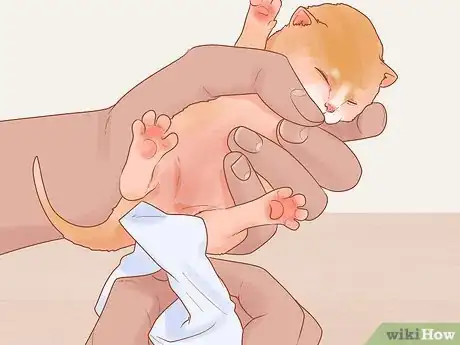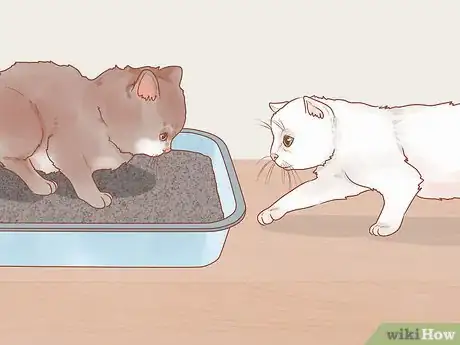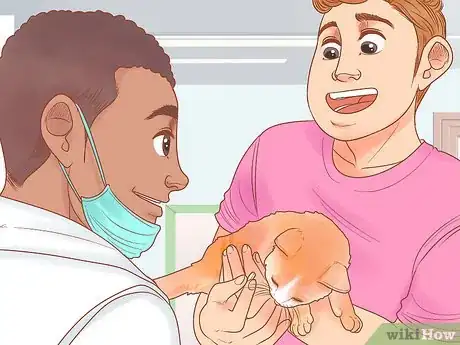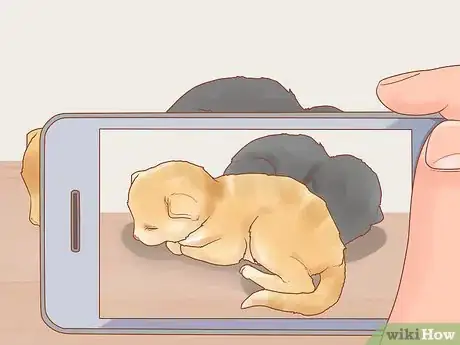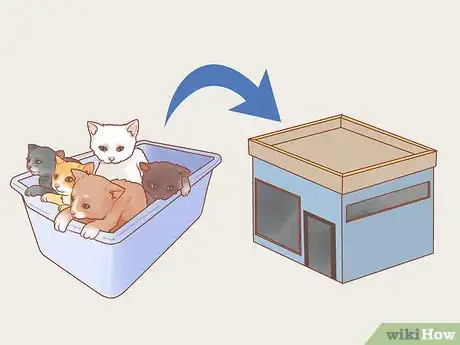This article was co-authored by Deanne Pawlisch, CVT, MA. Deanne Pawlisch is a Certified Veterinary Technician, who does corporate training for veterinary practices and has taught at the NAVTA-approved Veterinary Assistant Program at the Harper College in Illinois and in 2011 was elected to the board of the Veterinary Emergency and Critical Care Foundation. Deanne has been a Board Member of the Veterinary Emergency and Critical Care Foundation in San Antonio, Texas since 2011. She holds a BS in Anthropology from Loyola University and an MA in Anthropology from Northern Illinois University.
wikiHow marks an article as reader-approved once it receives enough positive feedback. In this case, 91% of readers who voted found the article helpful, earning it our reader-approved status.
This article has been viewed 84,308 times.
Fostering kittens is a wonderful and helpful thing to do. Your local animal shelter probably has small kittens in need of temporary homes before they are old enough to adopt. There may also be rescue organizations in your area that need help fostering kittens before they are adopted. Doing this takes time, effort, and motivation, as well as the strength to let the kitties go to their forever homes eventually. However, it will all be worth it when you see your kittens living happily in their new homes.
Steps
Preparing Your Home to Foster Kittens
-
1Find a room for the kittens. You will want to have a separate room for the kittens to live in. This should be a quiet place where they feel secure. Keep it dark during the night and light during the day to create a natural light cycle. It should also be away from any other pets in your home.[1]
- You may need to foster the mother cat as well when you accept kittens. Keep this in mind when bringing the cats in your home. The mother cat will need care, bedding, and food as well.
- If you can't give the kittens their own space that can be blocked off, where they can be kept away from other pets, then you probably shouldn't be fostering kittens.
-
2Kitten-proof the cats' room. Kitten-proofing means getting all the things that could be dangerous to small kittens out of the room. If the room is cluttered, it may be a good idea to move out desks, chairs, shelves, or bookshelves. Move out anything that you care about or could be dangerous for the kittens. Also consider moving out beds or other furniture that makes hiding easy for kittens, as it is not fun to spend your time trying to get the kitten out from under furniture.[2]
- Put away all things that are small, such as hair clips, ties, small toys, beads. Also move electrical wires or cables out of the kitten's reach. If you wouldn't leave something in a room with an unsupervised toddler, you shouldn't have it in the kitten room.
Advertisement -
3Give the kitten a bed. You will want to have a bed for the kittens to sleep in, to go to relax, and where the mother can nurse them. It should have a top and feel enclosed. Layer it with towels, blankets, and other soft stuff layers.[3]
- Make sure that everything you use can be laundered if it gets dirty. It is likely that the kittens will have accidents and you will need to wash their bedding often.
-
4Supply food and water. Near the bed you should place food and water bowls, if the kittens are old enough to eat on their own. The best are trays, which are long and shallow containers that are good for a lot of kittens eating at once. Don't use bowls that are too deep, as the kittens will have a hard time accessing food and water.[4]
- If the kittens are needing to be bottle fed, check in with the shelter to get bottles and milk formula, or order it at your local pet store or online.
-
5Give the kittens toys. You may want to get a couple of soft toys and some feather chasers to entertain the kittens. If the kittens are older, you may also consider getting a cat tree, as these can provide hours of fun and a nice place for the kitties to relax.[5]
- Giving the kittens toys will entertain them and minimize the trouble they can get into if they are bored.
-
6Provide training pads and a litter box. You will definitely want to get training pads if the kittens are not litter-trained. You can spread them out all over the floor and especially over the bed.[6]
- You will also need a litter box. Get one that has open sides and that lies low, so that the kittens can easily access it.
Finding a Kitten to Foster
-
1Contact your local animal shelter. Almost all shelters provide fostering opportunities for members of the community and would really appreciate your help. Before you can foster, however, you need to get approved by the shelter and fill out all the necessary paperwork.[7]
- The best time to find a fostering opportunity is spring (otherwise known as kitten season). This is the time when most kittens are born and end up homeless at the animal shelter. During this time, the shelters are often overcrowded with newborn kittens, and could use your help.
- Most shelters will want verification that you are at least 18 years old, have space for a kitten, that you are allowed to have a kitten (if you rent your home), and that you can pass a criminal background check.
-
2Go to a training session. You may need to go to a training session where shelter staff will explain in depth how to take care of the kittens. This training is especially important if you are going to foster any kittens with special needs, such as a kitten that is ill or needs rehabilitation from an injury.
- Once you have been approved to foster and you have done your training, it may take a while before you get your first kittens to foster. It all depends on what the needs of the shelter or rescue are at the time.
-
3Decide what kind of kittens you want to foster. Ask the shelter what kind of kittens they have available. There are two different kinds of foster kittens: kittens with a mother cat and orphaned kittens. Caring for young orphaned kittens less than three weeks of age can be very demanding, as you are providing for all of their needs. Kittens with a mother are much easier to care for.[8]
- If you foster a kitten that has a mother you will also be taking in the mother cat. The mother cat will do almost all of the work, including nursing, cleaning, keeping the kitten warm, feeding, and stimulating the kittens' bowels.
- If you are fostering for the first time, you will probably want to ask the shelter for kittens that have a mother. Without the mother, kittens face a far higher risk of becoming ill and dying.
-
4Bring the kittens home. Make sure you bring a pet carrier or get one at the shelter, as you should never have kittens loose in your car. Roll up the car windows and try to drive relatively slow, so as to not scare the kittens. When you get home, take the kittens to a separate room and get them settled in. Give them a while to relax and get used to their environment.[9]
- If you can, try to bring some of the kittens' bedding or toys with you when you take them home, as this will provide comfort.
- Before you bring the mother cat and the kittens home, ask the rescue or vet to have them examined for fleas. If they have fleas, try to have them treated before the cats enter your home.
Feeding Kittens
-
1Let the mother do care work. If the kittens are with a mom and still nursing, let her take care of them. She will feed them and clean them herself, so you don't need to do that. However, you will need to keep a close eye on them in order to make sure each kitten is getting plenty of milk and attention.[10]
- If there is a runt in the litter, make sure you give that kitten a little extra time with the mother cat alone, without the other kittens to compete for food.
- Make sure the mother cat is eating plenty of food. Feed her either dry or wet kitten food for as long as the kittens are nursing. The kitten food will give her the protein she needs to produce milk.
-
2Bottlefeed young mother-less kittens. If the kittens are still bottle feeding, make sure you feed them every two to three hours. Before feeding, warm the formula to 99–101 °F (37–38 °C). Wrap the kitten in a towel to keep it secure and then feed it until it is full. The employees at the shelter or rescue should give your clear instructions about this process and how long to continue it.[11]
- Do not feed the kittens cow milk. Instead, give them special kitten formula. You can buy this from a vet or pet store.
- Remember, very young kittens will even need feedings every 2 to 3 hours, even in the middle of the night.
- You can pre-mix enough formula for the kitten for 24 hours but you need to keep it refrigerated. Only heat as much formula as you will use for one feeding.
- When first bottle feeding a kitten, it may have a hard time latching on. Be patient, keep trying, and make sure that the nipple of the bottle has a big enough hole in it to release drops of milk. If all else fails, you can call the shelter or rescue for help.
-
3Help the kittens defecate and urinate right after feeding. If the kittens you are fostering are very young, you may need to help their digestive system develop. After each feeding, wet a cotton ball with warm water and gently massage the kitten's rectum until it defecates. To help the kitten urinate, rub the cotton ball over its genitals. This is crucial for the kitten's developing digestive processes.[12]
- This process replicates what the mother would usually do with her tongue.
-
4Wean the kittens onto solid food. When the kittens are about 5 or 6 weeks old, they should be transitioned onto solid food. You may want to start by feeding them wet kitten food, and then begin supplementing that with dry food. This is done by slowly adding pebbles of dry food to the wet food and increasing it as they age.[13]
- If the kittens are eating on their own already, that's good. Feed them three times a day and let them eat their fill. Kittens generally need as many calories as they can get.
Taking Care of a Kitten's Health and Happiness
-
1Keep the kittens warm and clean if there is no mother cat. Kittens cannot regulate their own temperature well. Usually the mother cat will keep them warm and clean, but if there is no mother, it will be your job to make sure that the kittens are clean, dry, and warm. Make sure that there is no food or feces stuck to the kitten's fur.[14]
- You can put a heating pad specifically made for pets to provide a warm spot in their nest. Only warm half of the nest, and put the heating pad under the blankets. This will let the kitten go to the cooler corner if they get too warm. Do not use a heating pad made for humans.
-
2Litter-train the kittens. To do this, after every feeding (nursing, bottle feeding, eating solid food etc.), place the kitten in the litter box. It should then do its business. If a kitten has an accident, quickly pick it up as soon as possible and place the kitten in the litter box. With persistence, the kitten should learn how to use it.[15]
- Kittens will usually learn how to use the litter box on their own or from their mother. Just make sure that the litter box is far from their food and kept clean. You can reinforce litter box use by praising the kitten after it uses the box.
- The litter box will need to be scooped at least three times a day, and the litter changed at least twice a week. Use clay litter instead of other types of litter, as clay litter can't be ingested as easily.
-
3Spend time with the kittens every day. Make sure you hold the kittens frequently, petting them and picking them up. Play with the kittens a lot. The more time you spend with them, the better socialized they will be to people throughout their lives.[16]
- Spending time with the kittens is the best part of fostering, so enjoy it.
- Touch their paws a lot, as they will need to be comfortable with it in the future to have their nails clipped.
-
4Always wash your hands. In order to protect the kittens, you, and any other pets you have from disease, you should wash your hands before and after handling the kittens. A kitten's immune system is still developing, so you need to protect it from everything you can.
- You also want to keep any illnesses that the kittens might have brought with them away from your existing pets.
-
5Watch for any signs of illness in the kittens. Most kittens that are fostered will appear healthy when they are placed in your care but it is always possible for illnesses to develop. Look for lethargy, fur loss, breathing problems, diarrhea, scratching, vomiting, discharge, or lack of appetite in the kittens. If the symptoms persist, call the vet.[17]
- If the kittens have goop coming from their eyes or nose, call the vet or go to the animal shelter to have the kitten looked at. In most cases, you will then be asked to give the kitten medication until the goop is gone.
-
6Take the kittens to veterinary appointments. When you sign on to foster kittens, you will need to agree to take them in for a variety of veterinary appointments. This typically includes signing them up for spaying or neutering and taking them in to have it done.[18]
- There may be other veterinary appointments for the kittens, depending on their health and what veterinary procedures have been done on them before you took them in. In many cases you will need to get them a variety of vaccinations and have their general health assessed by a veterinarian.
-
7Allow the kittens to leave their room for periods of time. If you want to, start to let the kittens leave the room for short periods of time once they are seven or eight weeks old and have been at your house for at least a few weeks. However, they should always be accompanied by you and never allowed to run around loose, especially if you have other animals.[19]
- Don't force the kittens to interact with other cats or dogs as this can result in injury and fear.
- Always supervise the kittens carefully, and keep all doors closed.
-
8Take photos and videos of the kittens, if possible. Your shelter will appreciate cute photos and videos being supplied when the kittens are up for adoption. They can post them online, on their website or on a pet finding websites. Typically, you can email the foster coordinator the pictures.
- If you can, also include a small bio of each kitten. Include a general summary of their personality, which will be helpful for adoptive families considering the kitten.
-
9Take the kittens back to the shelter, when the time comes. This is the hardest part of fostering, as you have likely grown close to the kittens you are fostering. Remember that you have greatly helped this animal and it will have a great new home and wonderful life thanks to your efforts.[20]
- If you want to, you can ask your shelter if they would let you know when the kittens are adopted and, if possible, the email of their adopters if you would like to keep in contact.
References
- ↑ http://bestfriends.org/resources/kitten-foster-manual
- ↑ http://bestfriends.org/resources/kitten-foster-manual
- ↑ http://bestfriends.org/resources/kitten-foster-manual
- ↑ http://bestfriends.org/resources/kitten-foster-manual
- ↑ http://bestfriends.org/resources/kitten-foster-manual
- ↑ http://bestfriends.org/resources/kitten-foster-manual
- ↑ https://www.oregonhumane.org/get-involved/volunteer/foster-care/
- ↑ https://www.oregonhumane.org/get-involved/volunteer/foster-care/
- ↑ http://bestfriends.org/resources/kitten-foster-manual
- ↑ http://bestfriends.org/resources/kitten-foster-manual
- ↑ http://bestfriends.org/resources/kitten-foster-manual
- ↑ http://bestfriends.org/resources/kitten-foster-manual
- ↑ http://bestfriends.org/resources/kitten-foster-manual
- ↑ http://www.kalamazooanimalrescue.org/public_docs/How_to_Care_for_Orphaned_Kittens.pdf
- ↑ http://bestfriends.org/resources/kitten-foster-manual
- ↑ http://bestfriends.org/resources/kitten-foster-manual
- ↑ http://bestfriends.org/resources/kitten-foster-manual
- ↑ http://bestfriends.org/resources/kitten-foster-manual
- ↑ http://bestfriends.org/resources/kitten-foster-manual
- ↑ https://www.oregonhumane.org/get-involved/volunteer/foster-care/
About This Article
To foster kittens, start by preparing a separate room for them away from any other pets you already have in your home. Next, kitten-proof the room by moving out any clutter or large furniture that will give the kittens places to hide. Additionally, put a bed in the room for the kittens to sleep in, and layer it with towels and blankets so it’s soft. Then, place shallow food and water bowls, and a low-sided litter box near the bed so the kittens can easily access them. Finally, spend time and play with the kittens every day to get them used to being handled. For advice from our Veterinary reviewer on how to find kittens to foster, read on!


